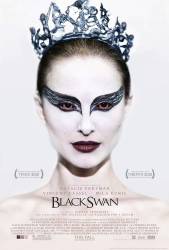Factual error: In the scene where Natalie Portman travels from her house to Lincoln Center she is riding the 1 subway train. The model train shown is a R142, which only serves the 2,4,5 trains. The one 1 train line is actually served by the R62A.
Factual error: Toward the end after Nina dances the black swan and she's in her dressing room, Lily knocks on the door to congratulate Nina on her performance. When Lily turns around to leave, her huge double-wing tattoo is visible on her back. No ballet company will allow a dancer to perform on stage with tattoos that have not been properly covered up.






Answer: **Spoiler Alert** I would say you are correct about the movie being a metaphor for descent into madness, but also displays themes of repressed sexuality and transformation. As the main character is given the lead role, she must play dual roles, one good and one evil, with the hallucinations representing the latter. Towards the beginning, Nina only embodies the personality traits of the white swan, innocence and grace. As the film gradually progresses, Ninas hallucinations represent her metamorphosis into the seductive and mysterious black swan. The film expertly convinces the audience that Lily (Mila Kunis) is out for Nina's role. In a twist ending, it is revealed that Nina has imagined most of her encounters with lily (including their sexual one) and has instead been battling herself, such as breaking away from her domineering mother and coming to terms with her sexuality. At the end, Nina really does stab herself (but actually hallucinates it is Lily she is stabbing) and her fate is left ambiguous.